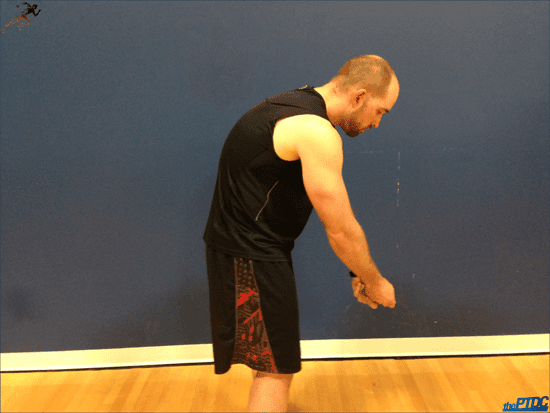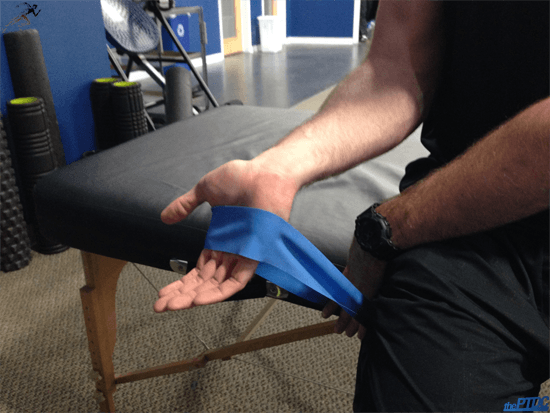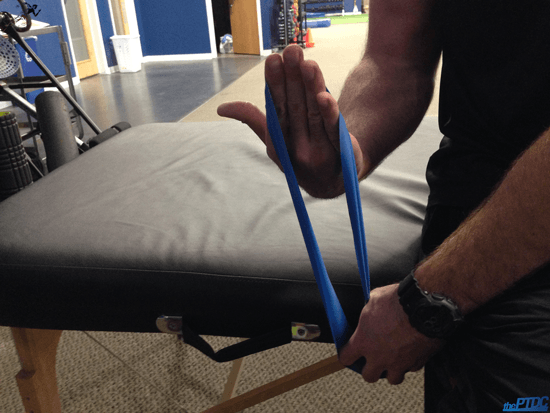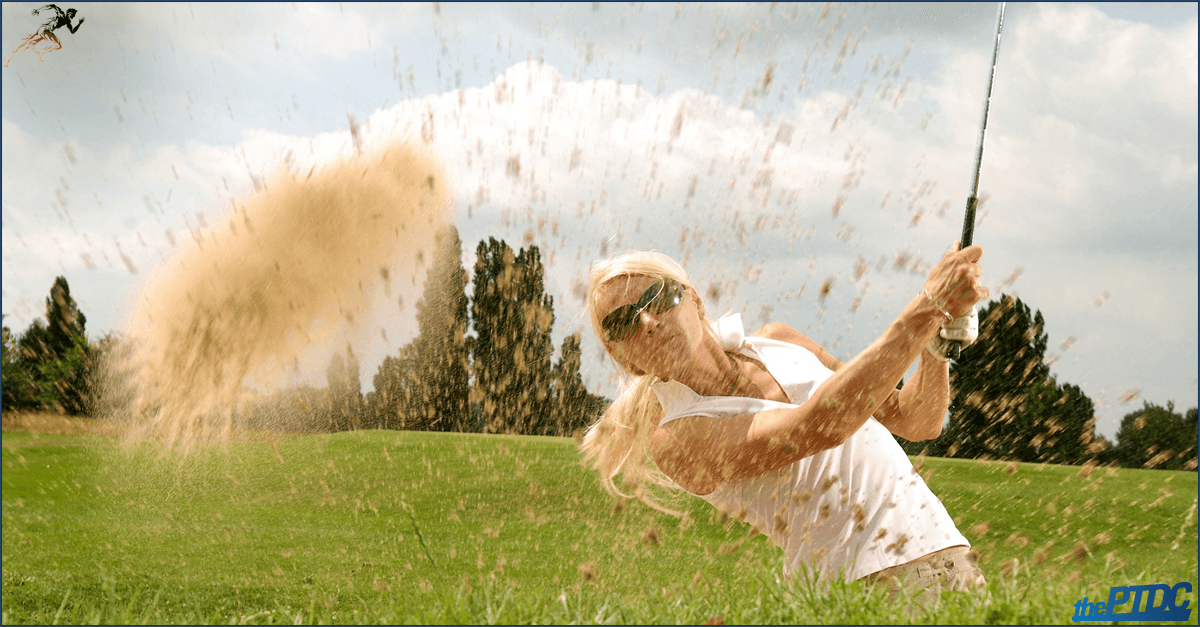Not all golfers may look like athletes, but the successful ones are doing more than a few cable twists and 12 oz. curls at the 19th hole.
But before we start ripping weights off the floor and throwing medicine balls around, we need to establish a strong base of proper range of motion, stability, and mobility.
Serious golfers want one thing: to play more golf (better). They can't be playing more golf if they're constantly dealing with injuries.
The big three injuries seen in golfers are:
- low back pain
- golfers elbow
- general shoulder pain.
Low back pain is by far the most common, as the golf swing is a complex and explosive movement. More times than not, lower back pain is from a lack of mobility in the hips, thoracic spine, or shoulders. Because these areas aren't as mobile as they should be, the lumbar spine tends to inherit some of the mobility to pick up the slack -- which shouldn't be happening.
The pain could also be from a more serious issue, bulging disks, arthritis or even bone fracture -- which would call for a referral out.
Golfers elbow (pain on the medial epicondyle, or the inside of the elbow) is more of an overuse injury of inflammation and should be managed accordingly. Icing, resting, and avoiding a lot of heavy grip work are advised while the elbow is inflamed. If the elbow is feeling good, incorporate some basic forearm/grip strength exercises to aid in increasing forearm strength.
Shoulder pain is most common in the lead shoulder (left shoulder of a right handed golfer) of the golfer. This is typically from the golfer lacking thoracic rotation range, or hip rotation range of motion, and thus bringing their lead arm too far across their body in an attempt to get a bigger backswing. General shoulder pain may also stem from a lack of scapular stability in both shoulders.
The following workouts for golfers are some of my favorite exercises for increasing thoracic spine mobility, improving forearm strength, and improving scapular stability.
Thoracic Mobility
1) T-spine open book/windmill stretch. Keep your legs stacked, lower back at neutral, and give a big exhale as you open up your chest.
Programming: Use as part of a dynamic warm-up or cool down for 2 sets of 6-10 reps
2) Kneeling thoracic extension dynamic stretch. This is a great one for golfers who set up with their shoulders rounded forward or in C posture. When the thoracic spine is stuck in a flexed position, it makes it pretty hard to rotate.

Kneel on a pad while placing your elbows on a flat bench. While holding onto a dowel or even a golf club with a shoulder width palms up grip, sit the hips back while maintaining neutral lumbar spine. Exhale as you sink the hips back and pull your hands back over the back of your head.
Programming: Use as part of a dynamic warm-up or cool down for 2 sets of 6-10 reps.
Forearm Strength
When working with golfers elbow, remember to base your exercises off of the current symptoms. If the elbow is currently aggravated, first ice and try getting some soft tissue work done.
1) Banded flexion and extension exercises, with open fist.
Programming: Use as a filler exercise in between main exercises for 2 sets of 10-15 reps.

The set up for band wrist flexion

End range for band wrist flexion.
If the elbow feels good, you can incorporate some more grip work, with a focus on building up the forearm muscles. Have your client try some basic forearm curls, hammer curls, or my personal favorite, farmer carries.
Scapular Stability
1) Farmer carries. Focus on keeping the scapula locked in place, and not letting the weights swing.
Off- Set Farmer Carry:
2) Progression: One-arm - bottoms up kettle bell waiter carry (this can easily be regressed to a bottoms-up carry in the rack position). This works grip strength as well, so avoid it if your client is dealing with forearm or elbow pain.
Bottoms Up 1-Arm KB Water Carry:
Programming: Use as a filler exercise between main lifts, carry for 20-40 yards for 3-4 sets.
3) One arm low trap/Y-Raise. Lying on a table or a bench, have the client raise thumbs to the ceiling in a "Y". Make sure the client is retracting from the scapula and not shrugging up the traps. The main goal is to activate the lower trap area and get a slight upward rotation in the scapula.
Programming: Start un- weighted, with 2-second hold at the top for 2 sets of 6-8 reps.
Prone Low Trap Raise
Try these exercises if these three common problems show up in your clients and re-screen after a few weeks of work. Once these mobility and stability issues have been cleared up in your golfers, then it's time to start training for power!
Power Training
Just because golf is a rotational sport doesn't mean that all exercises must be rotational cable chops.
When the swing is broken down, we see hip rotation, hip extension, and the upper body follows suit. Powerful hip extension is one of the big keys for a powerful golf swing.
The first exercise for increasing hip extension strength is...
1) The Deadlift
Glutes are the king of power in the golf swing. There are many variations of the deadlift, but my preference with golfers is either a rack barbell deadlift, or a dumbbell deadlift from a bench. I do this to decrease the range of motion (especially for my older clients who may have history of low back problems), while still allowing good hip extension and glute firing to occur.
Dumbbell Deadlift From Bench:
Programming: For a strength goal, I like to see my golfers lift 100% of their bodyweight for 3-4 sets of 4-6 reps per set with perfect form.
This is also usually pulled from a position just below the knees. (Example - a 160-pound golfer should be able to lift 2, 80-pound dumbbells from a flat bench for 4-6 reps.)
2) Dumbbell split squat. This is a great exercise because not only does it work the glutes, hams, and quads, but also serves as a great lower body stability exercise.
Dumbbell Split Squats:
(Example - a 160-pound golfer should be able to lift 2, 40-pound dumbbells for 8 reps on each leg)
The next two exercises focus more on rotation and speed strength:
1) Rotational Med-Ball Throws. These should be done from both sides, and using a medicine ball that is roughly 1 pound for every 20 pounds of body weight.
Programming: For explosive strength, 3-5 sets of 3-5 reps from each side is ideal.
(Example - a 160-pound golfer should be using an 8-pound medicine ball).
Med Ball Throw:
*The reason we want to train from both sides is to create balance across the body. Golf is such a one-sided sport that we need to make sure to train both sides of the body.
The second explosive rotational exercise I love is the rotational jump. This is an advanced exercise and should be used with the right type of client. The rotational jump can be a stand-alone exercise, or used as a 90 degree with a jump up to a box. As with the medicine ball tosses, use maximum effort and minimal reps.
Programming: For explosive strength, 3-5 sets of 3-5 reps is ideal.
Rotational Jump:
Rotational jumps put an emphasis on separating the lower body from the upper body, and thus getting them to fire in proper golf sequence.
So how would I put this all together for a client looking to increase power in the golf swing?
An Example of a Full Templated Program I May Use
Dynamic Warm-up - work mobility, speed, core activation/stability and incorporate corrective exercises
1 - Medicine Ball Side Throws - 3 sets of 3-5 throws - each side
Rest 60-90 seconds (incorporate fillers for core stability, scapular stability, hip mobility, during rest periods)
2 - Box Jumps/Rotational Jumps/Lateral Bounding - 3 sets of 3-5 jumps
Rest 60-90 seconds (incorporate fillers)
3A - Dumbbell Deadlift from Bench - 3 x6-8
3B - Low Cable Single Arm Row - 3 x8
3C - Farmer Carry - 3 x20 yards
Rest 1 Minute
4A - Dumbbell Split Squat - 3 x8
4B - Single arm cable or bench chest press - 3 x8
4C - Anti-Extension/Flexion Ab Exercise - 3 x10-15
Rest 1 Minute
Finish with any additional correctives, mobility work, and stretching.










